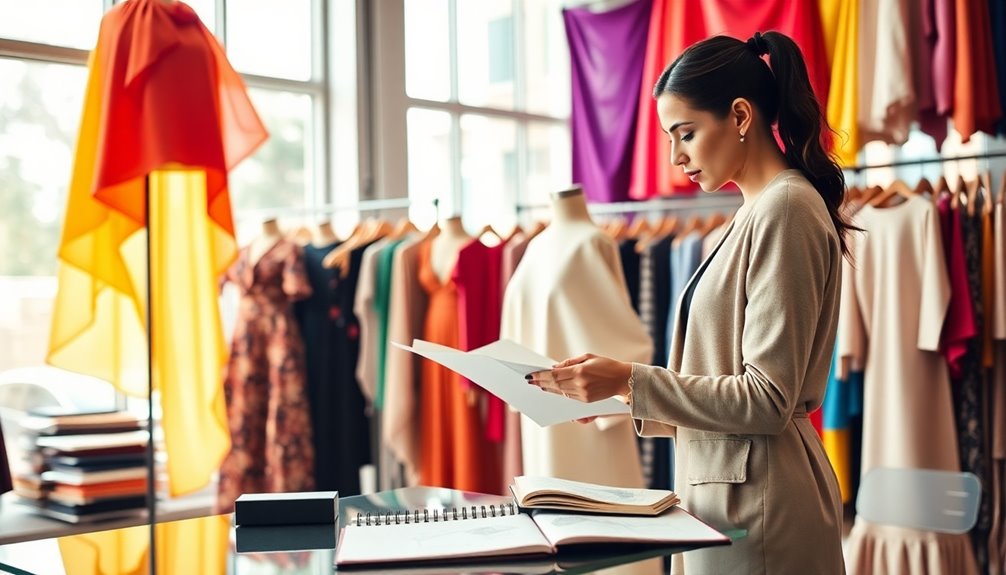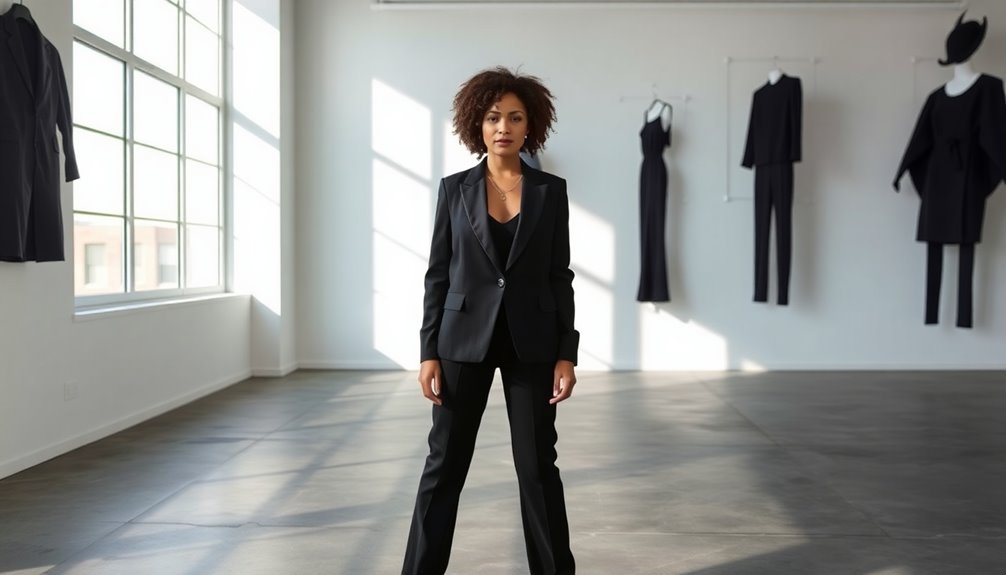A fashion buyer is someone who selects apparel and accessories for retail stores, blending creativity with financial strategy to drive profits. Your role involves analyzing sales data, attending fashion shows, and engaging with suppliers to negotiate prices. You'll need strong financial skills for budgeting and inventory management, as well as interpersonal skills to communicate effectively with stakeholders. Keeping up with trends through market research is essential, and career advancement can lead to higher positions like merchandising manager. If you're interested in the specifics of this dynamic career, there's more to explore as you continue your journey.
Key Takeaways
- A fashion buyer selects apparel and accessories for retail, aiming to maximize profits through informed product selection.
- They analyze sales data and trends to make strategic inventory decisions and prevent overstocking or shortages.
- Buyers attend fashion shows and trade events to stay updated on upcoming styles and market trends.
- Strong negotiation and interpersonal skills are essential for building supplier relationships and securing favorable purchasing terms.
- Career progression typically leads from assistant buyer to senior roles, with specialization opportunities enhancing earning potential and impact.
Definition of a Fashion Buyer

A fashion buyer plays a crucial role in the retail industry by selecting the apparel and accessories that fill store shelves. You work on behalf of various retail entities, such as fashion stores, department stores, or your own boutique. Your main responsibility is maximizing company profits through careful product selection while staying within the store’s budget and financial constraints. As a fashion buyer, you must constantly stay updated on the latest fashion trends and consumer demands to ensure that the merchandise you select will appeal to your target market. You also work closely with suppliers and manufacturers to negotiate prices, monitor inventory levels, and ensure timely deliveries of products. In order to excel as a fashion buyer, strong analytical skills, a keen eye for detail, and a passion for fashion are essential.
To excel in this role, you'll likely need an associate or bachelor's degree in fields like marketing or fashion merchandising. A solid grasp of fashion trends and styles is crucial, as are quantitative skills for managing inventory and maximizing profits. An analytical mind and a keen eye for style will serve you well in this competitive environment.
You'll also engage with suppliers and designers, meeting with various vendors to review clothing, shoes, and accessories. Understanding current fashion trends helps you stay updated on the latest trends, and you'll negotiate prices while ensuring that goods meet quality standards.
Building and maintaining relationships with suppliers is essential for success in your role as a fashion buyer. Understanding market trends and customer demand will guide your purchasing decisions effectively.
Key Responsibilities of Buyers

As a fashion buyer, you're tasked with a diverse range of responsibilities that directly impact the success of your retail operation. You analyze sales data to identify which products are performing well and which ones are lagging, ensuring you make informed selections that align with customer preferences and trends.
Attending fashion shows and trade events keeps you in the loop with upcoming styles and necessary product details. This engagement allows you to stay ahead of fashion trends that can influence your buying decisions.
Budget management is also crucial. You negotiate with suppliers for the best deals, ensuring that your purchases contribute to profitability. Analyzing financial data helps you make sound merchandising decisions, like determining competitive pricing that meets market conditions.
In inventory management, you monitor stock levels to avoid both overstocking and shortages. Ensuring timely deliveries and quality control is key to maintaining the brand's reputation. You check prototypes before finalizing purchases to guarantee they meet your standards.
Finally, you cultivate strong relationships with suppliers and coordinate closely with design and production teams. By networking with industry professionals, you stay informed on developments that could affect your buying decisions, solidifying your role as a pivotal player in fashion retail.
Market Research Techniques
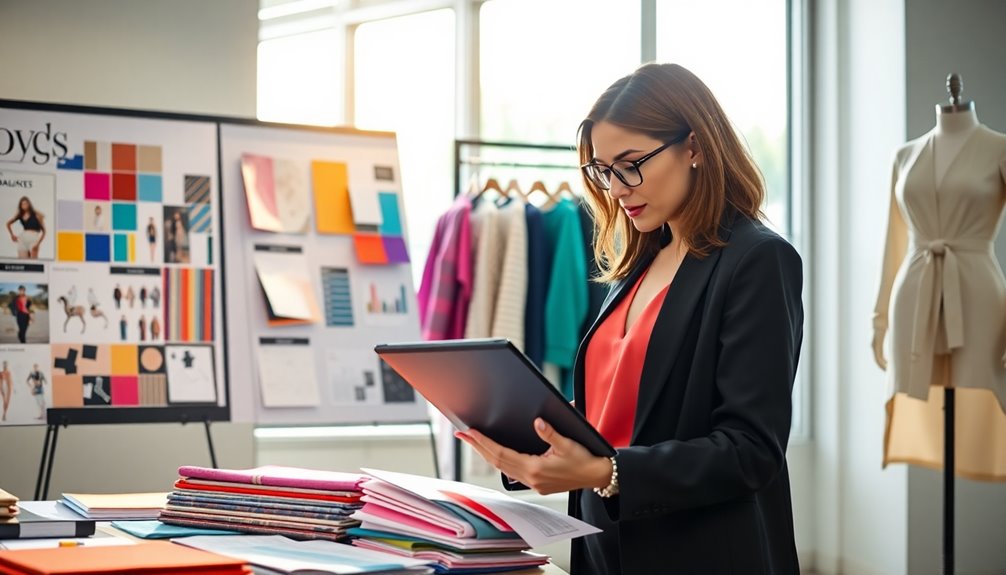
Understanding market research techniques is vital for fashion buyers aiming to make informed decisions that resonate with consumer preferences. You'll want to utilize both primary and secondary research methods to gather comprehensive insights.
Start with surveys to collect data on customer demographics and preferences. Focus groups can provide deeper insights through moderated discussions, while interviews—whether in-person or via phone—allow you to gather detailed feedback directly from customers. Field research is also important; observing shopping behavior helps you understand real-world customer interactions. Leveraging predictive modeling can further enhance your understanding of consumer preferences and potential market trends. Additionally, employing high-quality content in your communications can significantly improve engagement and trust with your audience.
On the secondary side, industry reports offer valuable data on market trends and consumer spending. Social media engagement is another key area to analyze consumer sentiment and brand mentions. Don't forget about customer reviews to gauge satisfaction levels and identify improvement areas. Additionally, maintaining relationships with suppliers is crucial for effective negotiations that can influence your purchasing decisions (supplier relationships).
To efficiently collect and analyze data, tools like Google Analytics and CRM systems are invaluable. They help track online behavior and manage customer interactions. Using data visualization tools can simplify complex data, making it easier to spot trends.
Trend Analysis Methods

Trend analysis methods are essential for fashion buyers looking to stay ahead in a fast-paced industry. You'll want to tap into various resources like social media platforms such as Instagram and Weibo for real-time insights on what's trending.
Attend trade shows, events, and runway shows to spot current and upcoming styles. Consider using fashion forecasting services like WGSN to gain in-depth industry insights.
Analyzing fashion elements is crucial too. Pay attention to silhouettes, colors, fabrics, and trims, while also considering customer buying patterns and previous sales data.
Understanding geographical breakdowns and client segmentation will help you predict trend behaviors more effectively. Additionally, the rise of social media has drastically changed the pace at which trends emerge and decline, making it essential for buyers to stay updated.
Leverage technology and analytics to enhance your trend analysis. Use computer vision technology to sift through millions of social media images, and apply machine learning algorithms to forecast trends up to two years in advance.
Predictive analytics will help you project future sales and lifecycles of trends.
Finally, integrate all this data into your decision-making. Utilize market insights platforms, internal systems, and regular trading reports to ensure your merchandising decisions are grounded in accurate, comprehensive data.
Financial Skills Required
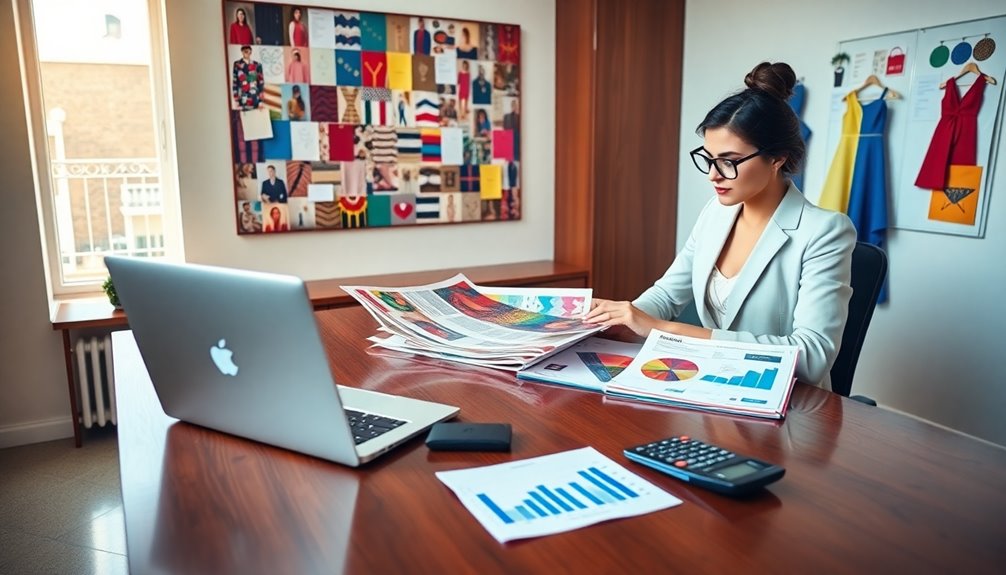
A fashion buyer's financial skills are crucial for navigating the complexities of the industry. You must manage buying budgets effectively, ensuring you meet financial targets while making informed purchasing decisions.
Forecasting sales and revenue helps you analyze financial data to evaluate product performance and profitability. Knowing how to calculate pricing, profit margins, markups, and markdowns is essential for achieving cost-effective outcomes that maximize your return on investment. Additionally, leveraging consumer behavior insights allows you to fine-tune your purchasing strategies based on anticipated demand.
Proficiency in retail math is also vital. You'll analyze inventory turnover and financial ratios, compiling weekly trading reports to identify strong and slow sellers. This insight allows you to make strategic pricing and promotional decisions based on solid financial analysis.
Additionally, you'll monitor budgets, prepare financial reports, and maintain a basic understanding of accounting principles to manage costs efficiently. Tracking inventory and deliveries, you'll calculate key performance indicators (KPIs) like sell-through and sell-out rates.
Finally, managing inventory levels is critical. You need to analyze sales data regularly to ensure you meet demand without excess stock, maintaining quality control to protect the brand's reputation.
Your financial oversight will ultimately optimize returns and support successful merchandising strategies.
Negotiation Tactics

Mastering financial skills sets the foundation for effective negotiation tactics in fashion buying. Start by preparing thoroughly—gather extensive information about your supplier, including their needs, limits, and financial health. Understanding market trends and pricing benchmarks can significantly enhance your negotiating power. Tailor your approach by researching the buyer's habits; knowing their likes and dislikes can make a difference.
Building strong relationships with suppliers is crucial. These connections facilitate smoother negotiations and ensure quality and timely delivery. Identify leverage points, such as volume purchasing, and emphasize the value of your partnership. Use your market influence to negotiate better terms.
During negotiations, be ready to make concessions but be mindful of your limits. Implement strategies like anchoring to set the bargaining range, while remaining cautious of the supplier's anchoring attempts. Stay calm and confident to avoid appearing weak. Remember that maintaining profit margins during discussions is essential for long-term success.
Clear communication is key—ensure all parties understand the terms to prevent misunderstandings. Be flexible and willing to compromise on aspects like price or delivery dates. Document all agreements for clarity, and don't hesitate to walk away if the terms aren't favorable.
This approach positions you for successful outcomes in your negotiations.
Interpersonal Skills Importance
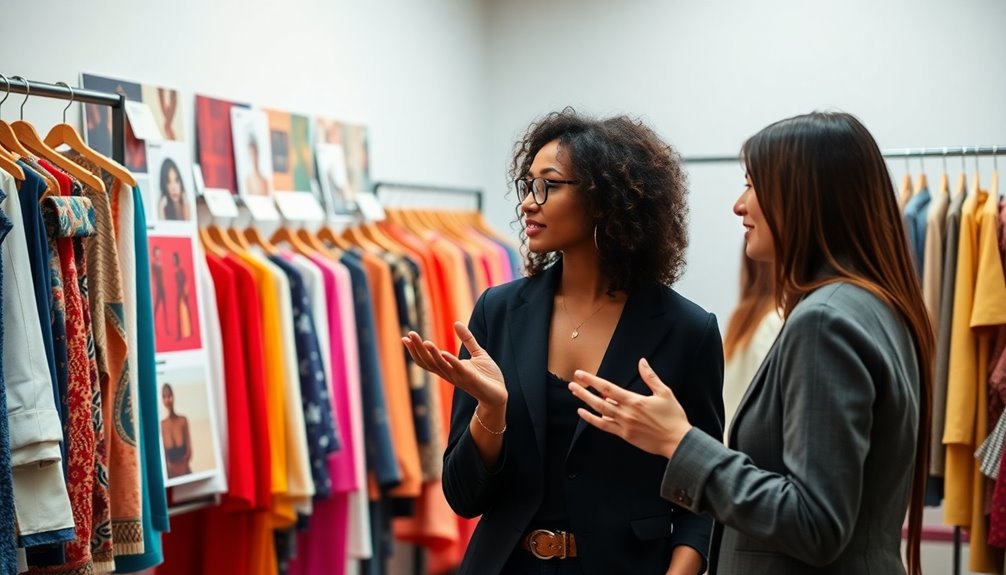
Interpersonal skills play a vital role in the success of a fashion buyer. You'll find yourself collaborating with various stakeholders, including designers, suppliers, and marketing teams. Strong communication skills are essential; you need to articulate the value of clothing and accessories to executives while ensuring that your vision aligns with cross-functional teams.
Building and maintaining relationships is crucial. You'll negotiate prices and delivery terms with suppliers, fostering trust and cooperation to ensure timely product availability. Your ability to manage cultural differences with global suppliers can significantly impact your success in the industry. Additionally, leveraging analytics tools can enhance your negotiation effectiveness by providing valuable data on market trends and supplier performance.
Teamwork is another key aspect. You'll work closely with merchandising departments and visual merchandisers to create compelling displays that attract customers.
Participating in meetings and trade shows keeps you updated on trends, allowing for effective collaboration and alignment of goals.
Career Path Overview

Navigating the career path of a fashion buyer requires a blend of education, experience, and ongoing development. You'll typically start with a bachelor's degree in fashion merchandising, marketing, or a related field. Supplementing your education with certificates, like The New School's Fashion Buying and Merchandising Certificate, enhances your qualifications. Focus on coursework in brand management, consumer behavior, and data analysis to build a solid foundation.
Gaining entry-level experience is crucial. Look for internships, part-time retail jobs, or apprenticeships to gain practical knowledge. Update your portfolio to showcase your skills in trend forecasting and market analysis, and make the most of networking opportunities at job fairs. Additionally, consider the promising growth opportunities available in this field as you build your career.
As you progress, expect to start as an entry-level buyer or assistant buyer. With experience, you can move into more senior roles, such as buyer or merchandise manager, where strategic decision-making becomes key.
To further your career, stay engaged with industry trends through fashion shows and trade fairs, and consider pursuing certifications like the Certified Purchasing Professional. Building strong relationships with suppliers and staying updated on software advancements will also serve you well in this dynamic field.
Advancement Opportunities

Advancement opportunities in the fashion buying field can lead you to exciting senior-level positions that come with increased responsibilities and compensation. As you gain knowledge and experience, you could graduate to roles like buyer, merchandiser, or merchandise manager.
In these positions, you'll make strategic decisions, manage teams, and control purchasing or merchandising processes, earning between €45,000 and €70,000 or more, depending on your organization. Understanding sustainability and ethical sourcing is becoming increasingly important for buyers to align with market demands.
With significant experience and a proven track record, you can progress to management or director-level roles. These positions involve leading teams, setting strategic direction, and managing budgets, often with salaries exceeding €70,000 and potentially reaching six figures in larger organizations.
You might also want to pursue specialized career paths in areas like luxury fashion or e-commerce. Specialization can significantly enhance your earning potential.
To further your career, focus on professional development through courses and networking at industry events. Building a strong professional network is crucial for advancement, and staying updated with industry trends will keep you competitive in this dynamic field.
Specialization Areas in Buying

In the competitive world of fashion buying, specializing in specific areas can set you apart and enhance your career prospects. By honing your skills in niche categories, like menswear, womenswear, lingerie, or accessories, you deepen your expertise and attract targeted opportunities.
You can also consider market segments, such as luxury goods, fast fashion, or sustainable fashion. Each brings unique challenges and consumer demands that you'll need to navigate expertly. As buyers must also analyze market trends, understanding these segments becomes even more crucial.
Additionally, focusing on product categories like footwear, activewear, or swimwear can position you as a go-to buyer for those specific items.
Geographic specialization is another avenue. By understanding trends in the US, European, or Asian markets, you can cater to distinct consumer preferences and behaviors. You might even dive deeper into regional markets, analyzing differences between East Coast and West Coast fashion trends.
Ultimately, choosing a specialization not only enhances your knowledge but also makes you a valuable asset in the fast-paced fashion industry. By aligning your expertise with market needs, you can elevate your career and make a significant impact in the buying realm.
Frequently Asked Questions
What Personality Traits Are Important for a Successful Fashion Buyer?
To be a successful fashion buyer, you need a mix of analytical skills and charisma.
You've gotta stay trend-focused, decipher market data, and understand consumer behavior. Confidence is key for decision-making and negotiation, while your interpersonal skills help build strong relationships with suppliers.
Being competitive drives you to secure the best merchandise, and organizational abilities keep you on top of multiple tasks.
Balancing these traits will set you apart in the industry.
How Does a Fashion Buyer Stay Motivated in a Competitive Industry?
Staying motivated in a competitive industry requires you to embrace challenges and celebrate small victories.
You can set specific goals and track your progress, which keeps you focused. Surrounding yourself with like-minded professionals and networking can inspire fresh ideas.
Staying updated on trends fuels your passion, while attending fashion shows reignites your creativity.
What Tools Do Fashion Buyers Use for Inventory Management?
As a fashion buyer, you rely on various tools for effective inventory management.
You use barcode scanning for efficient tracking and cloud-based solutions for real-time data access.
Integrated POS systems keep your sales data synchronized with inventory levels, while platforms like Shopify POS and Lightspeed Retail help manage stock across multiple locations.
Automated reorder points and comprehensive reporting tools allow you to stay ahead of inventory needs, ensuring you never run out of essential items.
How Does a Fashion Buyer Collaborate With Marketing Teams?
As a fashion buyer, you collaborate closely with marketing teams to discuss promotional strategies and plan seasonal campaigns.
You coordinate on in-store displays and online content, ensuring they align with the brand's vision.
By analyzing customer feedback, you adjust marketing efforts to highlight best-sellers and promote slower-moving products.
Together, you develop sales strategies that stay within budget, using data to guide your creative decisions and optimize profit margins.
What Challenges Do Fashion Buyers Face in Their Daily Work?
As a fashion buyer, you face numerous challenges daily.
You've got to predict trends accurately while managing tight budgets and fluctuating consumer preferences.
With constant pressure to make profit-driven decisions, you juggle administrative tasks and vendor relationships.
The demands of frequent travel and long hours can strain your work-life balance.
Plus, you must navigate the ever-changing landscape of fashion, ensuring timely deliveries while keeping a close eye on inventory and quality control.
Conclusion
In conclusion, being a fashion buyer is both dynamic and rewarding. You play a crucial role in shaping retail offerings, from conducting market research to analyzing trends and managing finances. By honing your interpersonal skills and understanding the industry's nuances, you can navigate your career path effectively. With various specialization areas and advancement opportunities, you can build a fulfilling career in fashion buying. So, if you've got a passion for style and strategy, this might just be the perfect fit for you!
